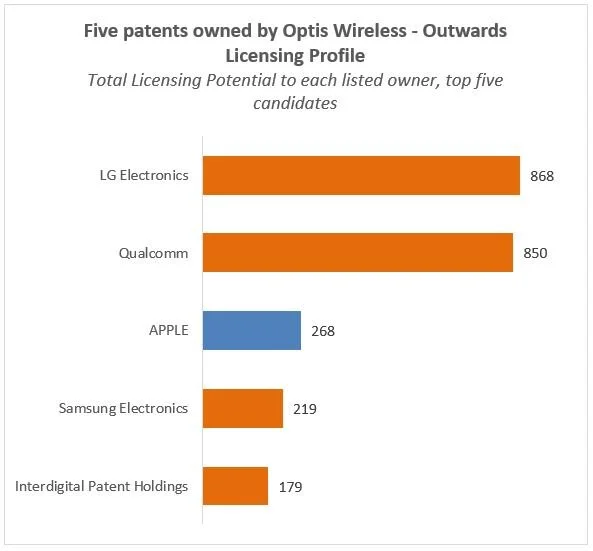Can the Outward Patent Licensing profile for Optis Wireless predict its $300 million judgement against Apple?
Aug 17 2021: Apple has been ordered to pay USD$300 million to Texan-based patent investment company Panoptis, after a retrial. This was a reduction of an earlier judgement of $500 million, and according to the above link, Apple plan to appeal this judgement.
The patents in question were originally were originally filed by LG Electronics, Samsung and Panasonic, and subsequently assigned to Optis Wireless, a subsidiary of Panoptis.
But was this outcome predictable?
Our last blog discussed the concept of Inwards and Outwards Licensing Profiles, and how these could be used to identify licensing opportunities. So what would these profiles show in this case?
Optis does not make products, so we only need to worry about the Outwards Licensing Profile in this case (Inwards Licensing Profiles are more concerned with Freedom-to-Operate risks). The link above referred to five patents being litigated, and we entered the five patent numbers into Ambercite, using a priority date filter of patents filed after April 2005, which is the earliest priority date for these patents.
Using the process discussed in the earlier blog, we have produced the following “Outwards Licensing Profile”:
Apple ends up in fourth position in the list. LG and Samsung are the sources of three of the asserted patents, and we can assume that when they sold these patents that they retained a license to these patents. Qualcomm also looks exposed, but maybe they already have a license to these patents, or do not infringe them. Interdigital Patent Holdings is also a patent investing company, and so not at risk from these patents.
So in this case, Apple was identified as a licensing opportunity for these five patents - as confirmed by the litigation.
Unknown vs Known citations - and the difference they make
Ambercite finds similar patents, and by extension licensing opportunities, by analysing patent citations. Other tools also provide patent citations, but we take two additional steps:
1) We rank all citations by our Similarity Score, which we calculate based on citation data.
2) We also analyse indirect citations (citations of citations), again ranked by Similarity Score. We call these patents ‘Unknown citations’ as they could be citations, but have not yet been listed as citations. For the same reason, we refer to direct citations as “Known citations”.
For Licensing Profiles, we also filter the data by a minimum Similarity Score, which is based on the number of patents we analyse.
What this means in practice is that we will find licensing opportunities that conventional citation analysis will miss.
And in this case? Our analysis found one known (direct) and 17 unknown (indirect) citations. So how much of a difference did these unknown citations make to this analysis?
This is shown in the figure below:
This shows that the vast majority of the Licensing Potential value we found in this analysis came from the Unknown citations. If we had instead relied on known citations, we might have missed the importance of Apple.
This has confirmed the value of the Ambercite approach to finding Licensing opportunities.
Want to try Ambercite for yourself?
Ambercite offers free trials, but to get the most of this, please contact us for a demonstration. You can try either option via the links below:


